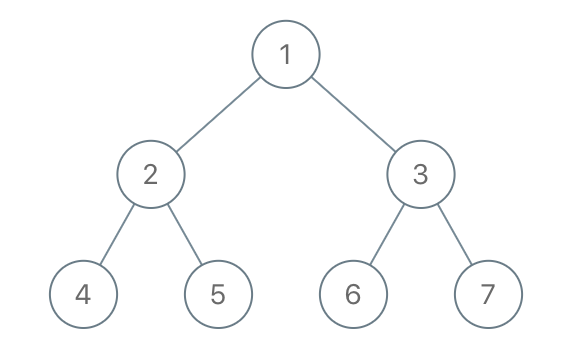- {x}
- Path With Maximum Minimum Value
- Distribute Candies to People
- Path In Zigzag Labelled Binary Tree
- Filling Bookcase Shelves
- Parsing A Boolean Expression
- New Users Daily Count
- Defanging an IP Address
- Corporate Flight Bookings
- Delete Nodes And Return Forest
- Maximum Nesting Depth of Two Valid Parentheses Strings
- Highest Grade For Each Student
- Reported Posts
- Print in Order
- Print FooBar Alternately
- Print Zero Even Odd
- Building H2O
- Number of Days in a Month
- Read More...

Delete Nodes And Return Forest
Given the root of a binary tree, each node in the tree has a distinct value.
After deleting all nodes with a value in to_delete, we are left with a forest (a disjoint union of trees).
Return the roots of the trees in the remaining forest. You may return the result in any order.
Example 1:

Input: root = [1,2,3,4,5,6,7], to_delete = [3,5] Output: [[1,2,null,4],[6],[7]]
Example 2:
Input: root = [1,2,4,null,3], to_delete = [3] Output: [[1,2,4]]
Constraints:
- The number of nodes in the given tree is at most
1000. - Each node has a distinct value between
1and1000. to_delete.length <= 1000to_deletecontains distinct values between1and1000.
Solution Explanation: Deleting Nodes and Returning Forest
The problem requires deleting nodes with specific values from a binary tree and returning the roots of the resulting forest (a collection of disjoint trees). The provided solutions leverage depth-first search (DFS) and breadth-first search (BFS) to efficiently achieve this.
Approach 1: Depth-First Search (DFS)
This approach uses a recursive DFS strategy. The core idea is to traverse the tree, process each node, and rebuild the tree structure based on whether a node should be deleted.
-
Initialization: A set
s(or a boolean array in some implementations) is created to store the values of nodes to be deleted. This allows for O(1) lookup time when checking if a node should be deleted. -
dfs(root)Function: This recursive function performs the following:- Base Case: If
rootisnull, it returnsnull. - Recursive Calls: Recursively calls
dfson the left and right subtrees, updatingroot.leftandroot.rightwith the results. - Deletion Check: If
root.valis ins(node should be deleted), it checks if the left and right children are notnull. If they exist, they are added to theanslist (representing the roots of the resulting forest) because they become the roots of new subtrees. The function then returnsnullto remove the current node from the tree. - No Deletion: If
root.valis not ins, the function returnsroot, preserving the node in the tree.
- Base Case: If
-
Main Function: The
dfsfunction is called on the root. If the returned value is notnull, it means the root node was not deleted, and it's added toans. Finally,ans(containing the roots of the remaining trees) is returned.
Time Complexity: O(N), where N is the number of nodes in the tree. Each node is visited and processed exactly once.
Space Complexity: O(N) in the worst case due to the recursive call stack (depth of the tree) and the ans list (in the worst case, all nodes except the deleted ones could become roots). The set s uses O(K) space, where K is the number of nodes to delete; this is typically much smaller than N.
Approach 2: Breadth-First Search (BFS)
This approach uses an iterative BFS strategy. It processes the tree level by level, using a queue.
-
Initialization: Similar to DFS, a set
delis used to store the values of nodes to be deleted. A queueqis initialized with the root node. The result listreswill hold the roots of the remaining trees. -
Iteration: The
whileloop iterates as long as the queueqis not empty.- Level Processing: The loop iterates through all nodes currently in
q. - Children Handling: For each node, its left and right children are added to the
qNextqueue, and if their values are indel, the children are set tonullin the parent. - Node Deletion: If the current node's value is in
del, its left and right children (if notnull) are added toresas new roots. - Queue Update: After processing all nodes at the current level,
qNextbecomes the newqfor the next iteration.
- Level Processing: The loop iterates through all nodes currently in
-
Root Check: Finally, if the root node's value is not in
del, the root is added tores.
Time Complexity: O(N), similar to DFS, as all nodes are processed once.
Space Complexity: O(W), where W is the maximum width of the tree. The queue can hold up to W nodes at any given time. In the worst-case scenario (a complete binary tree), W can be proportional to N, resulting in O(N) space complexity. The set del uses O(K) space (as in DFS).
Both approaches provide correct solutions with a time complexity of O(N). The choice between DFS and BFS might depend on factors like the expected tree structure and memory constraints. DFS might be slightly more space-efficient for deeply nested trees, while BFS might be preferred for wide trees where the maximum width is significantly smaller than the number of nodes.